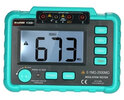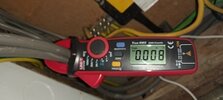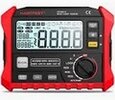There have been events, like Ian Smith when copper got scarce, and we had a short time with aluminium cables, and some poor quality plastic where the plasticiser has leached out, but in the main most rubber cable had stopped being used when in 1966 the rules changed on earthing lights, so pre-1966 often complete rewire is required, but post-1966 in most cases it can be tidied up and new consumer unit is all that is required.
Poor wiring practice can damage cables, when overloaded, so the starting point is the inspection and testing, my father (house built 1954) was well into DIY, with spur off spur. The old imperial cable seemed to stand this, it was approximately 3 mm², but the new 2.5 mm² showed signs of stress. So we have two meters which can show us if the cables are leaking an excess to earth.
The insulation tester uses in the main 500 volts,

and will give us a good indication to if a modern RCD/RCBO would trip, and is used on dead cables. The clamp-on ammeter however is used on live cables, and again shows the leakage if used in the correct way.

these will show faults, but in real terms, don't show if there are no faults. But one can quickly, specially with the latter, see if a new consumer unit can be fitted without a full rewired when also looking at types of cable where they terminate in the old fuse box.
There are other meters also used,

which also help to know if the existing wiring is up to scratch, it is not a job one can do with a simple multi-meter like the clamp-on shown, but there is little point in doing a full EICR (electrical installation condition report) if it is going to need a full re-wiring. You want some sort of quick report first, my father had a new consumer unit fitted, only to find the RCD would not hold in, this was around 2004, and the RCD was replaced with a simple isolator which was permitted back then, the full re-wire was done after his death, so around 2017, and the consumer unit he fitted ended up in the scrap.
And this has been an ongoing problem, we went from Bakelite to plastic around 1995, and since then we have kept changing what we considered as being required, with RCD's for just some circuits, then two RCD's for all circuits, then moving the RCBO's and from plastic to steel, adding SPD (surge protection device) and now the AFDD (Arc fault detection device) and RCD's changing from type AC to type A the list goes on, and all in the last 30 years. So my consumer unit fitted 5 years ago, would not comply if fitted today.
Each edition of the wiring regulations has a bit like this
BS 7671:2008 Requirements for Electrical Installations was issued on 1st January 2008 and is intended to come into effect on 1st July 2008. Installations designed after 30st June 2008 are to comply with BS 7671:2008.
The Regulations apply to the design. erection and verification of electrical installations, also additions and alterations to existing installations. Existing installations that have been installed in accordance with earlier editions of the Regulations may not comply with this edition in every respect. This does not necessarily mean that they are unsafe for continued use or require upgrading.
This from an old edition which was to hand. And it means if the installation is designed and the work is not completed for 5 years, as could be the case with a new power station or airport, and the regulations change, the design can still stand. Although not helpful when regulations are clarified rather than changed.
So if you planned the work today, you can in theory continue using those plans even if the regulations change. But this does not always work out in practice, as often the plan is in someone's head, rather than on paper as a hard copy. And I saw with my own son, how he was really into working as a sole trader, then realised how much more he could earn working for a large company, so gave up house bashing and followed the money. So if a job takes years you can be left high and dry.




